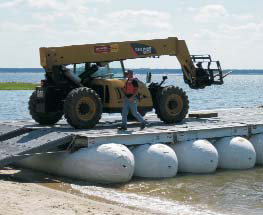Portable bridge
DOI: 10.1063/1.2982118
This month in Pearl Harbor, Hawaii, the US Army Corps of Engineers will test a floating bridge it says can be transported by ship, truck, or helicopter. US military and industrial partners worked with the army’s Engineer Research and Development Center in Vicksburg, Mississippi, to design a lightweight causeway system that can be transported in packages of up to four 3-meter long by 6-meter wide modules, which weigh about 2600 kilograms each. The modules are connected by compliant and compressive urethane joints and float on large tubes inflated with air from pressurized, carbon-spun bottles. In Hawaii eight modules will be used to test a 17 000-kilogram load; the causeway is being designed to support vehicles up to a 65 000-kilogram M1A1 Army tank. In the image, an 8000-kilogram forklift drives along the causeway deployed on a beach near Fort Eustis, Virginia. The bridge system is currently about 10% over its design weight goal, but technical manager Donald Resio thinks the goal will be met in a second R&D cycle. This project was funded by the advanced concept technology demonstration (ACTD) program within the Office of the Secretary of Defense to enable military and humanitarian operations to be carried out in ports and other waterways whose bridges were damaged by unforeseen events (see related article on

ARMY CORPS OF ENGINEERS





